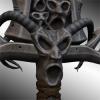-
Posts
698 -
Joined
-
Last visited
Content Type
Forums
Calendar
Gallery
Posts posted by The Candy-floss Kid
-
-
Mac OS X [4.5.40]: Crashes when switching from surface to voxel mode when vertex painted or with pbr materials.
Repeatable/ Consistent
osx 10.8.5
NVIDIA GeForce 9400
p.s any application setting advise for older macs ?
Performance on screen become instantly laggy when vertex paint is applied.
4.1 works like a dream on 10.6.8
-
Here's 3 great videos on digital sculpting techniques for setting up the face.
Understanding form and anatomy is one thing but applying a pragmatic system for success is another.
Combining the techniques demonstrated in these 3 videos will help you set up structure faster.
Whilst the software used is ZBrush, the techniques are just as applicable to 3DCoat.
Open House Webinar with Gio Napkil, Mold3D TVstart at 24.10 for face set up by quickly scoring lines for the main planes
Dylan Ekren, How to approach creating a 2D character in ZBrush Pt.2 Mold3D TV
start at 2.12 secs for quick overall face proportion set up.
Ryan Kingslien - Sculpting Form vs Line or Proportions.
Lines of separations to set up overlaps.
Hope it helps.
-
 1
1
-
-
Out of interest
1,if you select the both the polygonal object's retopo/ mesh group + it's uv group then scale it smaller in the work space does the issue disappear with the render camera?
or
2, Does the issue vanish if you subdivide the mesh, i.e is it perhaps a face smoothing issue with low polygons? -
A great challenge with fantastic results folks.
Thanks to all involved , particularly for communicating the technical issues and explanations in the process of bringing your work to completion.
-
CTRL+UP to create camera shortcut, CTRL-+LEFT/RIGHT to recall and CTRL+DOWN to delete last shortcut.
All shortcuts are stored in the saved file. -
Not exactly what you're asking for but useful nonetheless
-
 1
1
-
-
Import without voxelization
-
Or you may have accidentally held down the shift key (or is it cntrl) which will also move the gizmo.
-
Have you imported your mesh using the 'flat subdivision' option? This subdivides the mesh but keeps edges hard by offering supporting edges - equivalent to subdividing in ZBrush with smt off
-
I wonder why we do not have such similar functionality in 3D-Coat.
Couldn't agree more.
Array replications maybe easier within polygonal defined areas?
-
 1
1
-
-
The splashes look like geometry spaced along zbrush curve brushes which then are distorted and sculpted. Often times in zbrush polygonal geometry can be smashed and distorted and then dynameshed to form droplets.
You could do the same thing in 3DCoat with splash/droplet geometry spaced along splines and then distorted. You can also create little random sculpted drops and use merge on pen to place these over proxy shapes and merge together for further tweaking.
Particle systems are fine for water but not so much when you need fast control for illustrative purposes . To design your water you could use b/w fractal patterns in terrain editors such as Bryce or Vue or apply b/w images as masks in 3DCoat for extruding and further sculpting. These fractal noise patterns can be used as the basis for your water with further image editing and over painting to control heights and effects where required around your boat or object.-
 1
1
-
-
The directness of working with 3dcoat is explemplified by Gavin Ball's posts on youtube - using a limited set of tools to superb effect.
I also like 3D Coat for testng out ideas and scene placements quickly before committing to polygons etc - explemlified here by Sándor Veres 'Allexr'
Use both Apps - love both Apps for what they both allow.
-
 1
1
-
-
-
 1
1
-
-
Thanks Taros, added to my notes. Very helpful.
-
You could use the warp tool - twist to make threads or twisted braid.
-
3d coat limited overview
Aleksey Voznesenski
Pipeline 00 Introduction & Purpose of the Seriesmiskyo71
Short series on 3DCoat for retopo +uv of assets - using Max , ZBrush and 3DCoat.
3D Coat -for 2D artists looking to transition into 3D
By Gavin Ball
-
It would also be vital to have an option to art direct the flow with a flow brush, or even Curves.
A wonderful suggestion with so many possibilities particularly if it could be implemented intuitively for artists.
-
A well spotted issue in need of immediate rectification.
-
Yes fantastic news bought by HgCapital a private equity firm.
The fund seeks out investments to fund the growth and expansion of portfolio companies, that is, a collection of different companies, often from various industries. This approach is done to diversify the fund and mitigate the risk involved; the more companies in a funds portfolio, the greater the diversification, and the lower the overall risk of default or loss.
from: http://baselinescenario.com/2012/01/27/what-is-private-equity/
-
Modo has become pricier .
Blender however has not http://3d-coat.com/forum/index.php?showtopic=17212
Whatever way you splice it getting your PBR materials to show in other apps will take some jiggery-pockery.
-
 1
1
-
-
Hi Raul,
I'm curious about the pinch brush - does holding cntrl change the behavior?
It's hard to tell what holding cntrl is doing with the Pinch brush if anything?
I always feel that it would be good if holding cntrl when using Pinch could perhaps introduce the ability to lay down a sharper line to exaggerate planar/ angular changes of a form.
In other words that holding the cntrl key with Pinch applies a crisp linear scoring of the surface - similar to using the draw brush then applying pinch.
Try creating a stroke using the Draw brush - settings -68% focal shift, 14% falloff , depth 34%. After applying that stroke run over the stroke with a Pinch brush at 21% falloff and 3% depth. Doing so will give you a clear idea of the kind of scoring line I am talking about.
Out of curiosity is there a brush that is the opposite of pinch i.e one that expands out the distance between polys under the brush radius?
-
PigArt is well known in the Blender community for fab low poly scenes with charm and appeal.
Using extrusions + w to subdivide low poly block outs >use of Displace modifier driven by a brush texture “clouds” with a further modifier “Decimate” to triangulate the form and support the displacement. Sculpt out with proportional editing = simple and effective low poly blocking out.
Regardless of what software you use, the principles demonstrated underline the speed advantages of using low poly blocking out techniques for scene construction with regard quickly judging and modifying the compositional weight and balance of form and volume relationships to achieve a strong design before moving on to sculpting and higher resolutions.Grab a whistle put on your lycra shorts and dance to 'Broken Bridge' by PigArt.
channel:https://www.youtube.com/user/pigartt/videos-
 2
2
-
-
Daniele Angelozzi is a cool tutor with a great charm - thanks for posting.
-
Hopefully this will help with material id's:
http://3d-coat.com/forum/index.php?showtopic=14565 digmanExpert
Posted 09 June 2013 - 05:12 PM
Yes, you can create materials assigned to uv islands.
Before merging (baking) your model to the paint room.
Create under the Groups tab in the retopo room a new layer for each uv island.
Unwrap your model.
Now select a uv island and then in the Groups tab at the bottom there is a icon to move all those selected polygons to the layer you have currently selected.
The move icon is the second to last one.
Now merge to the paint room.
A material will be created for each layer which means you have assigned a different material to every uv-island.
The separate materials will show up under the Materials tab in the paint room.
Hope this helps and I believe it is close to what you are asking for...
The picture is just the quick test to show you when I exported the Obj ball model from the paint room and imported the model into Wings3D that the materials and color map loaded correctly plus of course they are under the correct group as well.
I did not rename the layers when creating them in 3DCoat as this was just to create an example.
and
MaloPosted 19 August 2014 - 08:24 PM
http://3d-coat.com/forum/index.php?showtopic=16549&p=112318
Posted 19 August 2014 - 08:24 PM
In Retopo Room
Every UV-set stands for a material.
Every Retopo Group stands for a Object.
This may be also contextually useful with regard materials and uvgroups
Adding Texture Resolution





Why Do People Keep Changing Things?
in General 3DCoat
Posted
You ain't kiddin' Brother!!
S'why I still use version 4.1
Condensing and perfecting the core functionality of what is required to create art?
You can do it musically with 3 strings and a tambourine .
Yours monastically ,
Brother Floss